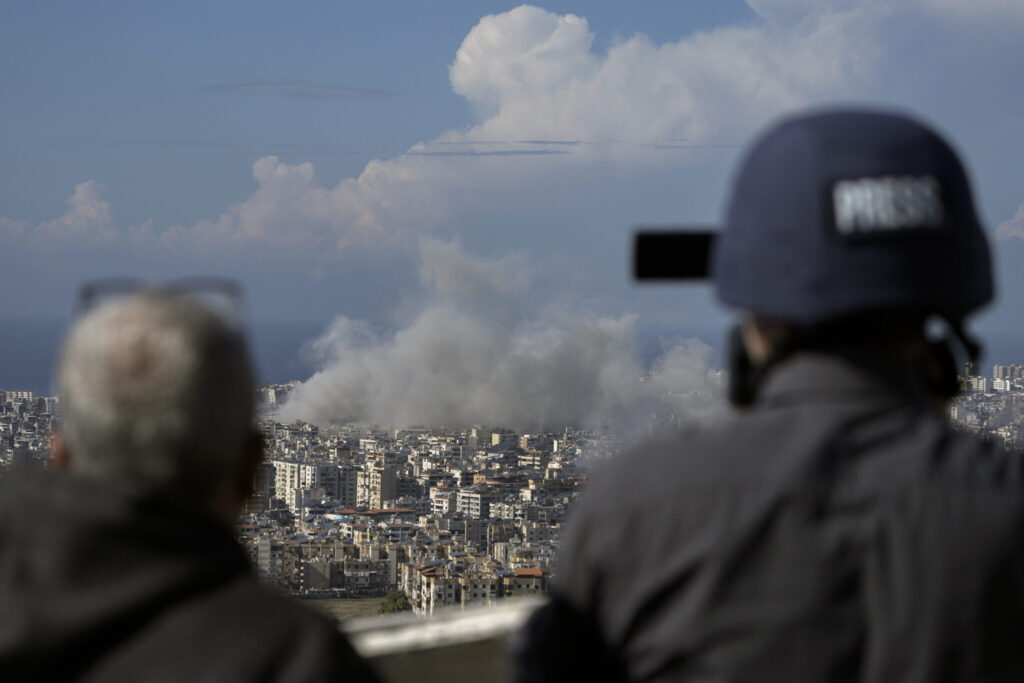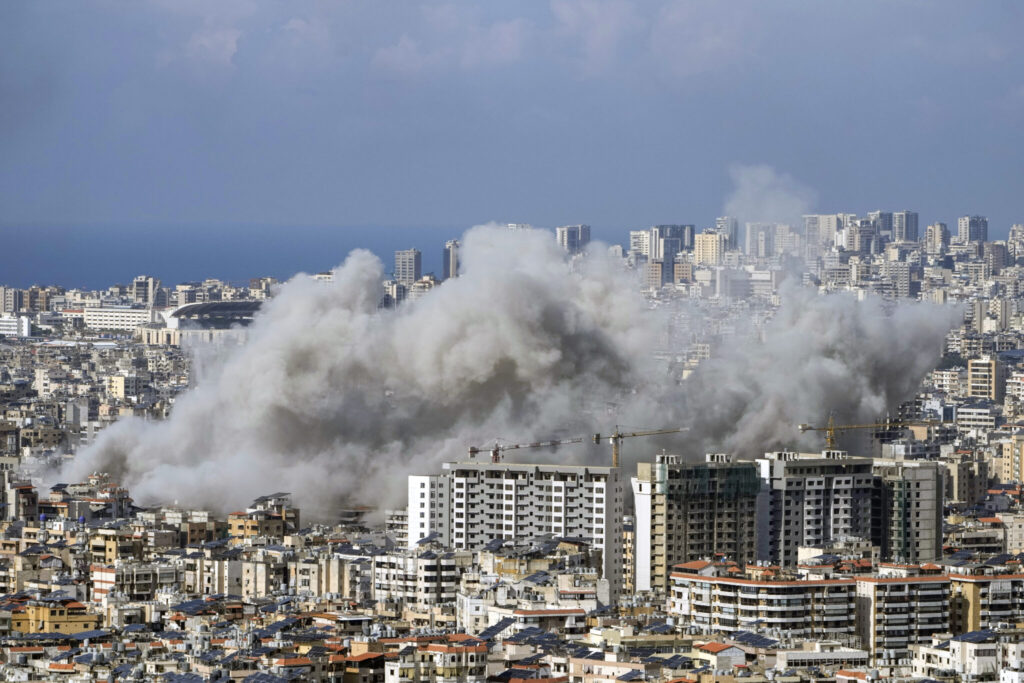Israel airstrikes/ Beirut explosions/ Gaza casualties/ humanitarian crisis/ aid restrictions/ Hezbollah/ Hamas/ Newslooks/ DEIR AL-BALAH/ Gaza Strip/ J. Mansour/ Morning Edition/ Israeli airstrikes targeted Beirut’s southern suburbs and killed 14 Palestinians in Gaza as conflict escalates on both fronts. The strikes occur as Israel faces pressure from the U.S. to increase humanitarian aid to Gaza. The death toll and tension continue to rise amid mounting international concern.

Israeli Airstrikes on Beirut and Gaza: Quick Looks
- Israeli Airstrikes: Targets include Beirut’s Hezbollah-heavy Dahiyeh and Gaza’s refugee areas.
- Casualties: 14 Palestinians in Gaza and 16 others, including Syrian refugees, in Lebanon.
- Humanitarian Crisis: U.S. pressures Israel to allow more aid into Gaza.
- Local Reaction: Civilians in Gaza face food shortages and evacuations as aid remains limited.
- International Concern: Ongoing strikes, high casualties, and limited aid have prompted global alarm.
Israeli Strikes Hit Beirut, Gaza; 14 Palestinians Killed
Deep Look
The conflict in the Middle East has intensified with fresh Israeli airstrikes targeting both Beirut and Gaza on Tuesday, resulting in a rising civilian toll and escalating tensions across the region. According to local medical sources, at least 14 Palestinians were killed in Gaza following strikes on a cafeteria and a residence. In Lebanon, Israeli warplanes bombarded Beirut’s southern suburbs, an area known for Hezbollah’s influence, after evacuation warnings were issued to residents in multiple homes. Reports indicate no immediate casualty figures from these attacks in Beirut.
The latest airstrikes mark a crucial moment as Israel faces increased pressure from the United States to allow more humanitarian aid into Gaza, with a deadline set by U.S. officials for ramped-up assistance. Despite Israel’s recent measures, including a temporary expansion of the humanitarian zone in Gaza, international aid groups say the response falls short of expectations. On Tuesday, a coalition of eight global humanitarian agencies reported that Israel had not yet met the U.S. aid thresholds, prompting concerns about the growing humanitarian crisis in Gaza.
Explosions and Casualties in Beirut
In Beirut’s Dahiyeh district, large explosions were reported soon after Israel ordered residents of 11 buildings to evacuate. Dahiyeh, a Hezbollah stronghold, has previously been the target of airstrikes. According to the Israeli military, these homes housed Hezbollah installations, though this information could not be verified independently. Late Monday, another airstrike in Ain Yaacoub, a village in northern Lebanon, reportedly left at least 16 people dead, including four Syrian refugees, with another 10 people wounded. Israel has not publicly commented on the incident in Ain Yaacoub.
Intensified Strikes in Gaza
The Israeli military continues its 13-month campaign in Gaza, initially triggered by a Hamas-led incursion into southern Israel in October 2023. As Israel intensifies its operations, Tuesday’s airstrike struck a makeshift cafeteria in the Muwasi area of Gaza, where displaced Palestinians have sought shelter. Medical sources at Nasser Hospital confirmed that at least 11 people were killed, including two children, in the strike, which occurred within a declared “humanitarian zone.” This zone is where many Palestinians displaced from northern Gaza have sought refuge under difficult conditions, with limited supplies and shelter.
Another Israeli airstrike in the Nuseirat refugee camp in central Gaza killed three people, including a woman, and injured 11 others, according to officials at al-Awda Hospital. These strikes occurred as the Israeli military issued a slight expansion of the humanitarian zone, where displaced Palestinians have been encouraged to seek shelter. In this desolate area of sand dunes and farmland, hundreds of thousands of displaced Palestinians live in sprawling camps, struggling with scarce resources along the Mediterranean coast.
U.S. Pressures Israel for Increased Aid
The escalating crisis in Gaza has raised serious concerns among international bodies and humanitarian organizations about the safety and welfare of the civilian population. An October 13 letter from U.S. Secretary of State Antony Blinken and Defense Secretary Lloyd Austin directed Israel to allow a minimum of 350 truckloads of aid to enter Gaza each day. To date, Israel’s response has not met this target. In October, an average of 57 aid trucks per day entered Gaza, increasing only slightly in early November to an average of 70 trucks daily, according to Israeli government data. The United Nations has reported even lower daily figures.
In a recent effort to address these concerns, Israel announced plans to open a new crossing into central Gaza and permit additional shipments of basic necessities. However, on Tuesday, only a limited number of supply trucks reached areas like Jabaliya and Beit Hanoun in the northern part of Gaza, where the ongoing siege has left many Palestinians on the brink of famine. Officials noted that the latest aid packages contained flour, canned foods, and bottled water, although previous deliveries have faced distribution challenges, often failing to reach the most heavily impacted areas.
Civilian Evacuations in Gaza Amid Rising Tensions
Israel’s military activity in Gaza remains focused on the northern areas, where Israeli forces are pushing to dismantle Hamas strongholds. As part of the siege, Israel has urged tens of thousands of residents to evacuate to southern Gaza, yet an estimated 70,000 remain in place, unable or unwilling to leave their homes due to limited alternatives. The United Nations has warned of a potential humanitarian catastrophe should the situation remain unchanged.
Eyewitnesses in Beit Hanoun reported that Israeli soldiers surrounded several schools sheltering displaced families, ordering occupants to evacuate. Mahmoud al-Kafarnah, a resident staying at one of these schools, described the tense atmosphere, with drones broadcasting evacuation orders and gunfire heard nearby. Hashim Afanah, sheltering with his family, reported Israeli forces were also moving through neighborhoods, ordering people to vacate homes and shelters.
Ongoing Conflict and Casualty Figures
The prolonged siege and military operations in Gaza have resulted in a high death toll. Health officials in Gaza estimate over 43,000 Palestinians have been killed in the past 13 months. This figure includes both militants and civilians, with reports indicating that over half of the casualties are women and children. The Israeli government asserts that it targets Hamas militants and accuses Hamas of operating within civilian areas, leading to the unintentional civilian deaths.
The origins of the conflict date back to October 7, 2023, when Hamas-led forces attacked southern Israel, killing approximately 1,200 Israelis and taking 250 hostages, including civilians. Around 100 hostages are still believed to be held in Gaza, with about a third presumed dead.
As diplomatic efforts struggle to ease the crisis, the ongoing airstrikes and humanitarian restrictions suggest the conflict may continue to intensify, drawing heightened international scrutiny and humanitarian concern.







